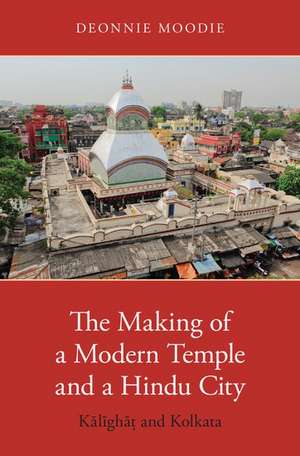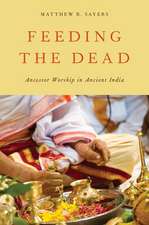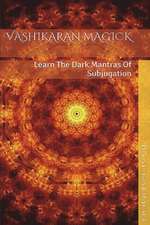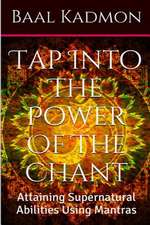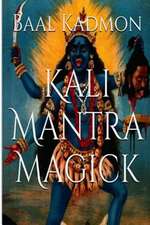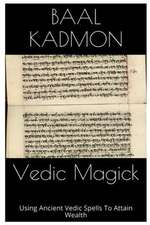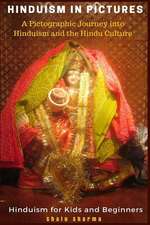The Making of a Modern Temple and a Hindu City: Kalighat and Kolkata
Autor Deonnie Moodieen Limba Engleză Hardback – 21 dec 2018
Preț: 545.41 lei
Preț vechi: 782.02 lei
-30% Nou
Puncte Express: 818
Preț estimativ în valută:
104.36€ • 109.26$ • 86.35£
104.36€ • 109.26$ • 86.35£
Carte disponibilă
Livrare economică 04-10 martie
Preluare comenzi: 021 569.72.76
Specificații
ISBN-13: 9780190885267
ISBN-10: 0190885262
Pagini: 240
Ilustrații: 18
Dimensiuni: 163 x 236 x 28 mm
Greutate: 0.5 kg
Editura: Oxford University Press
Colecția OUP USA
Locul publicării:New York, United States
ISBN-10: 0190885262
Pagini: 240
Ilustrații: 18
Dimensiuni: 163 x 236 x 28 mm
Greutate: 0.5 kg
Editura: Oxford University Press
Colecția OUP USA
Locul publicării:New York, United States
Recenzii
The author seems to suggest, the modern view that religion and economics belong in mutually exclusive domains needs to be reconsidered, since both are arguably integral to temple life. As a study of how such attitudes shift over time, this book is thus likely to be especially appreciated among those who reflect on the continuing centrality of religious sites within the dynamics of urban change.
A striking feature of this book is its analysis of court cases related to the Kalighat temple. Moodie offers a careful study of court judgments about the Kalighat temple to portray its modernization. Notably, she shows how "Indian judges worked to modernize" the temple's management. It is an indication that Moodie relies on all available sources of history, including oral traditions. The various judgments relating to the management of the Kalighat temple effectively converted it into a public institution.
This book is a good research work for historians, religious scholars, and scholars of Indian studies.
This book successfully outlines the pluralistic descriptions of emotions dealt with in Indian texts without categorizing them by Western concepts more dominant in the field.
By combining historical and ethnographic sources in interdisciplinary unison, Moodie illustrates how religious life at Kalighat is not diminishing but is attuning to the modern metropolis... Moodie's unique methodology and scope is truly commendable. As a result, her book contains considerable insights about Hindu temples in contemporary India, which will provide essential reading for those studying them.
Deonnie Moodie tells a fascinating story about the changing and contested meanings of the famous Kālīghāt temple in Kolkata (Calcutta) from the colonial past to the present day. Her book is elegantly and evocatively written, but it is also a solid work of interdisciplinary scholarship based on extensive, first-hand research. Moodie excellently combines the study of Hinduism and religion with anthropology, history, and legal studies, and her theoretical and comparative analysis of religion and modernization is closely tied to detailed empirical evidence.
Grounded in history and rich ethnographic detail, Deonnie Moodie's study of the Kālīghāt temple adds an important new perspective to the much-studied Kolkata middle class, linking the historical with contemporary middle-class efforts to modernize the temple. By focusing on the close interanimation of the sacred and the public, Moodie's study makes a critical contribution to understanding the sort of processes that are shaping a contested modernity in modern India.
Here in Kolkata, Moodie sets her discussion of the growing power of middle class religiosity amid the deeply material - sacrifice, blood, and tears - of the Kālīghāt temple. Throughout the extensive discussion, voices of the past mix with voices of the present and we hear not just the middle class intone their desires for meditative quiet and cleanliness but also the beggars and the priests, reminding us that the power of the temple may well rest as much in chaos as in order, as much in blood as in pamphlets, as much in the intensity of experience as in inner peace - a major contribution to the discussion of alternate modernities, the developing religious sensibilities of the Indian middleclass, and the increasingly visible presence of religion in urban landscapes.
It provides valuable insights and perspectives to the discussion on the dynamics between Hindu religious institutions and the state in contemporary India and is a highly recommended read.
A striking feature of this book is its analysis of court cases related to the Kalighat temple. Moodie offers a careful study of court judgments about the Kalighat temple to portray its modernization. Notably, she shows how "Indian judges worked to modernize" the temple's management. It is an indication that Moodie relies on all available sources of history, including oral traditions. The various judgments relating to the management of the Kalighat temple effectively converted it into a public institution.
This book is a good research work for historians, religious scholars, and scholars of Indian studies.
This book successfully outlines the pluralistic descriptions of emotions dealt with in Indian texts without categorizing them by Western concepts more dominant in the field.
By combining historical and ethnographic sources in interdisciplinary unison, Moodie illustrates how religious life at Kalighat is not diminishing but is attuning to the modern metropolis... Moodie's unique methodology and scope is truly commendable. As a result, her book contains considerable insights about Hindu temples in contemporary India, which will provide essential reading for those studying them.
Deonnie Moodie tells a fascinating story about the changing and contested meanings of the famous Kālīghāt temple in Kolkata (Calcutta) from the colonial past to the present day. Her book is elegantly and evocatively written, but it is also a solid work of interdisciplinary scholarship based on extensive, first-hand research. Moodie excellently combines the study of Hinduism and religion with anthropology, history, and legal studies, and her theoretical and comparative analysis of religion and modernization is closely tied to detailed empirical evidence.
Grounded in history and rich ethnographic detail, Deonnie Moodie's study of the Kālīghāt temple adds an important new perspective to the much-studied Kolkata middle class, linking the historical with contemporary middle-class efforts to modernize the temple. By focusing on the close interanimation of the sacred and the public, Moodie's study makes a critical contribution to understanding the sort of processes that are shaping a contested modernity in modern India.
Here in Kolkata, Moodie sets her discussion of the growing power of middle class religiosity amid the deeply material - sacrifice, blood, and tears - of the Kālīghāt temple. Throughout the extensive discussion, voices of the past mix with voices of the present and we hear not just the middle class intone their desires for meditative quiet and cleanliness but also the beggars and the priests, reminding us that the power of the temple may well rest as much in chaos as in order, as much in blood as in pamphlets, as much in the intensity of experience as in inner peace - a major contribution to the discussion of alternate modernities, the developing religious sensibilities of the Indian middleclass, and the increasingly visible presence of religion in urban landscapes.
It provides valuable insights and perspectives to the discussion on the dynamics between Hindu religious institutions and the state in contemporary India and is a highly recommended read.
Notă biografică
Deonnie Moodie is Assistant Professor of South Asian Religions at University of Oklahoma. Her research has been funded by her home institution as well as by Fulbright and Harvard University, where she earned her PhD. Moodie is especially interested in religion in urban India and the ways people of various class backgrounds negotiate urban spaces as sites of devotion, memory, monumentality, labor, and leisure.
